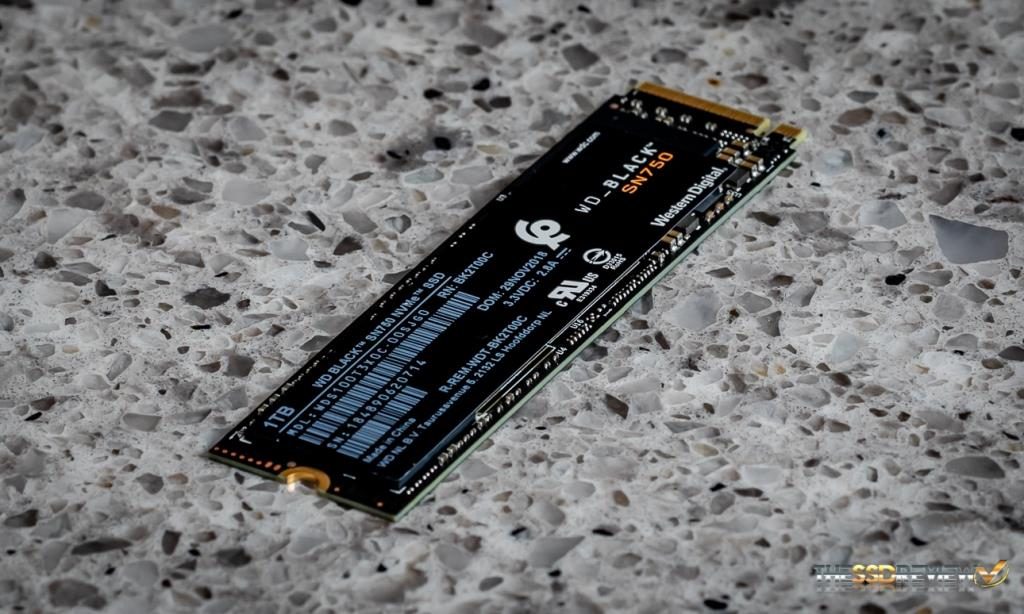It is not often that we dedicate the time to looking at an SSD that has been reworked simply through firmware, but our review today of the Western Digital Black SN750 NVMe SSD is just that. Physically, this SSD holds the same level of components as the WD Black/SanDisk Extreme pro Report we did just about a year ago. We will be the first to say there may be minor variances in the memory, an obvious fact as the product number has changed but for the most part, it is the same 3D 64-layer TLC NAND flash memory we have in the previous release. So… let’s take a look at this new SN750 and see exactly why it merits a new report.
The WD-Black SN750 is a PCIe 3.0 X4 (4 lane) M.2 (2280) SSD that uses the newest NVMe 1.3 protocol. It is available in capacities of 250GB, 500GB, 1TB and we are seeing advertising placement for the newest 2TB capacity, but very limited availability at the time of this report. This SSD comes with a limited 5-year manufacturers warranty and we are seeing pricing at Amazon right now of $79.99 (250GB), $139.00 (500GB), and $269.99 (1TB). We will be first to state that you can definitely find other 1TB SSDs for cheaper, just not with the same feature set of a true enthusiast class SSD.
The WD Black SN750 boasts 3.4GB/s read and 3GB/s write with 515K read and 560K write IOPS at low 4k random workloads. As with all recent TLC version SSDs, the buyer should be aware that performance is dependent on capacity, and in most cases, the lower capacities drop significantly in performance. For example, the SN750 250GB variant comes in at 3.1GB/s read and 1.6GB/s write with 220K read IOPS and 180K random write IOPS.
In our testing of the SN750, we have experienced absolutely no heat concerns but WD speaks of a purchase option with a matching EKWB heatsink as pictured here, but we haven’t seen availability as of yet.
As we had stated earlier, this SSD is the spitting image of the previous release WD Black. It utilizes their custom NVMe controller, two packages of SanDisk 3D 64-layer TLC NAND flash memory and a SKHynix DRAM cache ic. WD speaks to SLC cache technology which we discussed in most recent reports. For the most part, this is sold as the reason for SSD performance gain, however, its use is twofold with respect to the newer 3D TLC memory as it is required to reach those performance benchmarks, unlike previous SSDs. The ‘hiccup’ if you will of an SLC cache is that, once that cache fills, performance of the SSD drops significantly. We have addressed this significantly and will certainly do so here if it becomes evident.
This is a one-sided SSD which means that each NAND memory chip has a RAW value of 512GB storage. After the SSD is formatted, there is 931GB of storage space available to the user. Endurance is rated at 1200TBW for the 2TB model, and reduces by half for each lower version. Peak power is rated at 2.8A max, 100mW low power and 2.5mW in sleep mode.
 The SSD Review The Worlds Dedicated SSD Education and Review Resource |
The SSD Review The Worlds Dedicated SSD Education and Review Resource | 


“WD speaks to SLC cache technology which we discussed in most recent reports. For the most part, this is sold as the reason for SSD performance gain, however, its use is twofold with respect to the newer 3D TLC memory as it is required to reach those performance benchmarks, unlike previous SSDs.”
I think it should be pointed out that SLC caching has existed in every SSD utilizing TLC NAND since its advent, including planar 2D TLC flash. The ADATA SU800, for example, (released in 2016) utilizes a massive dynamic cache buffer due to what was originally an immature controller (SM2258) and the Micron 32-layer 384-Gbit TLC NAND, which is very slow stuff.
In addition, SLC caching algorithms increase endurance, often substantially.
pSLC caching is one part of the reason that 3D TLC surpassed 2D MLC in endurance (substantially) and peak performance, while increasing density; very important for consumers of all types, as MLC is significantly more expensive.
You Said you were going to address the slc cache and potential problems when exceeding it… ??
In every test I see, in real world testing you always stay below that magical slc cache limit, so these drives come out of it looking very good. It’s a bit disappointing because I use a lot of different drives for different purposes and I have not found 1 single TLC drive that shows good sustained sequential speed e.g. Yet review after review, these drives are touted as “just as good” as 970 pro or similar. I guess it comes down to workflow or particular needs of the user. As an example I just bought a jms583 10Gps pcb and a “thumb” drive enclosure for it. Using a thermal pad to dissipate the heat through the aluminium enclosure, even with a Usb 3 host I can sustain ~usb3.0 limit for the whole transfer using an excellent mlc drive. With a tlc drive, the speed drops off so badly after the cache is full, that it prolongs your transfer operation by maybe 200%. Now the same would be true for situations where you generally were working with massive amounts of data.
I mean, every other professional review shows what happens when the SLC cache buffers are exhausted. The thing is, it’s not easy to do. It takes software written just to saturate 30+ queue depths at speeds greater than 3.8GB/s. The majority of consumers could never do this. Certain workstation workloads can, but those people are generally looking at MLC based SSDs.
You state that operations can be prolonged by 200%. 200% of what, exactly?